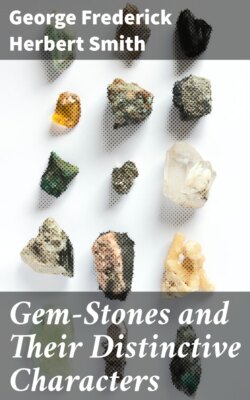Читать книгу Gem-Stones and Their Distinctive Characters - George Frederick Herbert Smith - Страница 14
На сайте Литреса книга снята с продажи.
Colour
ОглавлениеTable of Contents
All substances absorb light to some extent. If the action is slight and affects equally the whole of the visible spectrum, the stone appears white or colourless. Usually some portion is more strongly absorbed than the rest, and the stone seems to be coloured. What is the precise tint depends not only upon the portions transmitted through the stone, but also upon their relative intensities. The eye, unlike the ear, has not the power of analysis and it cannot of itself determine how a composite colour has been made up. Indeed, so far as it is concerned, any colour may be exactly matched by compounding in certain proportions three simple primary colours—red, yellow, and violet. Alexandrite, a variety of chrysoberyl, is a curious and instructive case. The balance in the spectrum of light transmitted through it is such that, whereas in daylight such stones appear green, in artificial light, especially in gas-light, they are a pronounced raspberry-red (Plate XXVII, Figs. 11, 13). The phenomenon is intensified by the strong dichroism characteristic of this species.
The colour is the least reliable character that may be employed for the identification of a stone, since it varies considerably in the same species, and often results from the admixture of some metallic oxide, which has no essential part in the chemical composition and is present in such minute quantities as to be almost imperceptible by analysis. Who would, for instance, imagine from their appearance that stones so markedly diverse in hue as ruby and sapphire were really varieties of the same species, corundum? Again, quartz, in spite of the simplicity of its composition, displays extreme differences of tint. Nevertheless, certain varieties do possess a distinctive colour, emerald being the most striking example, and in other cases the trained eye can appreciate certain characteristic subtleties of shade. At any rate, the colour is the most obvious of the physical characters, and serves to provide a rough division of the species, and accordingly in Table II at the end of the book the gem-stones are arranged by their usual tints.
